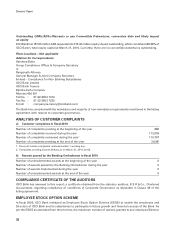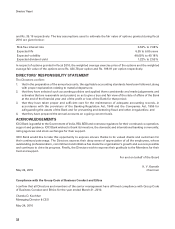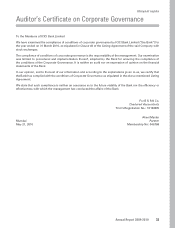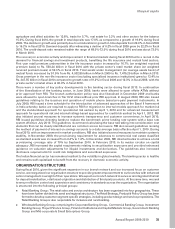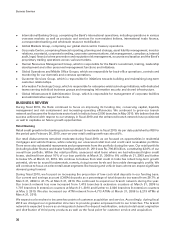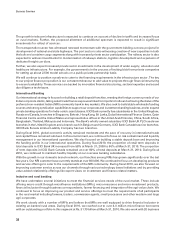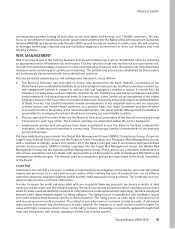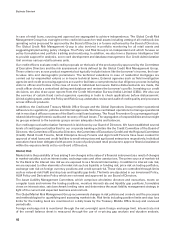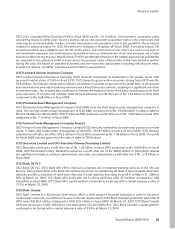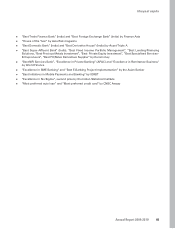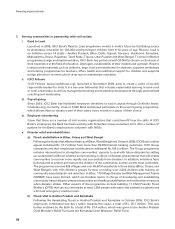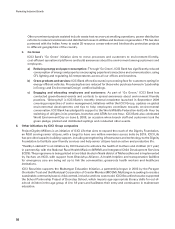ICICI Bank 2010 Annual Report Download - page 42
Download and view the complete annual report
Please find page 42 of the 2010 ICICI Bank annual report below. You can navigate through the pages in the report by either clicking on the pages listed below, or by using the keyword search tool below to find specific information within the annual report.Business Overview
In case of retail loans, sourcing and approval are segregated to achieve independence. The Global Credit Risk
Management Group has oversight on the credit risk issues for retail assets including vetting of all credit policies/
operating notes proposed for approval by the Board of Directors or forums authorised by the Board of Directors.
The Global Credit Risk Management Group is also involved in portfolio monitoring for all retail assets and
suggesting/implementing policy changes. The Policy and Risk Group is an independent unit which focuses on
policy formulation and portfolio tracking and monitoring. In addition, we also have a Business Intelligence Unit
to provide support for analytics, score card development and database management. Our Credit Administration
Unit services various retail business units.
Our credit officers evaluate retail credit proposals on the basis of the product policy approved by the Committee
of Executive Directors and the risk assessment criteria defined by the Global Credit Risk Management Group.
These criteria vary across product segments but typically include factors like the borrower’s income, the loan-
to-value ratio and demographic parameters. The technical valuations in case of residential mortgages are
carried out by empanelled valuers or in-house technical teams. External agencies such as field investigation
agencies and credit processing agencies are used to facilitate a comprehensive due diligence process including
visits to offices and homes in the case of loans to individual borrowers. Before disbursements are made, the
credit officer checks a centralised delinquent database and reviews the borrower’s profile. In making our credit
decisions, we also draw upon reports from the Credit Information Bureau (India) Limited (CIBIL). We also use
the services of certain fraud control agencies operating in India to check applications before disbursement.
A hind-sighting team under the Policy and Risk Group undertakes review and audit of credit quality and processes
across different products.
In addition, the Credit and Treasury Middle Office Groups and the Global Operations Group monitor operational
adherence to regulations, policies and internal approvals. We have centralised operations to manage operational
risk in most back office processes of the Bank’s retail loan business. The Fraud Prevention Group manages fraud-
related risks through forensic audits and recovery of fraud losses. The segregation of responsibilities and oversight
by groups external to the business groups ensure adequate checks and balances.
Our credit approval authorisation framework is laid down by our Board of Directors. We have established several
levels of credit approval authorities for our corporate banking activities like the Credit Committee of the Board of
Directors, the Committee of Executive Directors, the Committee of Executives (Credit) and the Regional Committee
(Credit). Retail Credit Forums, Small Enterprise Group Forums and Agri Credit Forums have been created for
approval of retail loans and credit facilities to small enterprises and agri based enterprises respectively. Individual
executives have been delegated with powers in case of policy based retail products to approve financial assistance
within the exposure limits set by our Board of Directors.
Market Risk
Market risk is the possibility of loss arising from changes in the value of a financial instrument as a result of changes
in market variables such as interest rates, exchange rates and other asset prices. The prime source of market risk
for the Bank is the interest rate risk we are exposed to as a financial intermediary. In addition to interest rate risk,
we are exposed to other elements of market risk such as liquidity or funding risk, price risk on trading portfolios,
exchange rate risk on foreign currency positions and credit spread risk. These risks are controlled through limits
such as value-at-risk (VaR) and stop loss and liquidity gap limits. The limits are stipulated in our Investment Policy,
ALM Policy and Derivative Policy which are reviewed and approved by our Board of Directors.
The Asset Liability Management Committee, which comprises wholetime directors and executives, meets on
a regular basis and reviews the trading positions, monitors interest rate and liquidity gap positions, formulates
views on interest rates, sets benchmark lending rates and determines the asset liability management strategy in
light of the current and expected business environment.
The Global Market Risk Management Group recommends changes in risk policies and controls and the processes
and methodologies for quantifying and assessing market risks. Risk limits including position limits and stop loss
limits for the trading book are monitored on a daily basis by the Treasury Middle Office Group and reviewed
periodically.
Foreign exchange risk is monitored through the net overnight open foreign exchange limit. Interest rate risk
of the overall balance sheet is measured through the use of re-pricing gap analysis and duration analysis.
40


